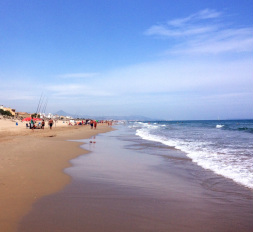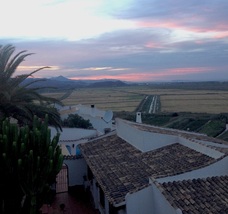 Chinstrap Penguin Chinstrap Penguin Everyone loves penguins, but after visiting Antarctica I now have an altered perception of the half fish, half fowl creatures. When wearing black and white, penguins are in their most adorable form. Even after many repeated encounters, both explorers and tourists find it impossible to refrain from snapping obscene quantities of photos of penguins. One early 20th century explorer commented on hearing the continuous clicking of the camera shutter against the backdrop of Antarctic silence every time their expedition encountered a new colony of penguins. I can understand why this is possible as during my three short weeks in the Antarctic region—I managed a ridiculous 1500 pictures of penguins. Somehow, they were so enthralling as they waddled about on the ice and snow in their natural habitat and I pitifully tried to capture those moments on film. It seemed that every new penguin met was immensely cuter than the last and click went the shutter again. But the truth is that these seemingly innocent penguins have a dark side. Contrary to the representations of media and the film industry, penguins are not adorable bundles of black and white. Penguins are pink. Making their nests in a fester of fetid pinkish-red guano-- excrement benefiting from the richness of a seafood diet and the scourge of the penguin colonies. Guano, or saltpetre, used widely in food preservation, is a resource over which a number of wars have been fought. You read it right—penguin poop is a valuable economic resource as it is teeming with fertilizing nutrients. And there is a chance that you have eaten it. Many people worry about the nations of the world wanting to drill for oil or mine for other resources in the Antarctic—and the continent is probably brimming with economic opportunities buried underneath all that ice. However, when the Madrid Protocol came into force, prohibiting activity on mineral resources, the most accessible resource given up in the Antarctic was penguin excrement. It is difficult to imagine headlines announcing the ruin of the Antarctic for the pursuit of guano harvesting, so hopefully the pink stained icy penguin habitat is safe from economic exploitation for just a while longer.  Scavenging Skua Scavenging Skua Yet despite wearing these noxious pink stained suits, penguins are still interesting creatures and it sometimes easy to forget that they are really birds rather than some other flippered aquatic species. Possibly the only time that penguins are truly black and white is when they are in the water, hunting and playing. The next biggest surprise of meeting real penguins and discovering that they are pink--is the first encounter with the synchronised swimming of a muster of penguins in their natural habitat something that is never observed in their cramped conditions in zoos. I have watched endless video hours of penguins sliding on snow, swimming near shore and stealing rocks from other penguins—but I had never seen them swim in unison like a pod of porpoises until I visited the Antarctic. Evolution hasn’t permitted for penguins to fly, but they sure can swim—which is a handy talent for (hopefully) escaping from predatory leopard seals. Unfortunately, while on land, their usual pink masquerade doesn’t assist in defending the colony from the predatory activities of the menacing skuas lurking overhead, stealthily looking for opportunities to steal a tasty egg or a fluffy penguin baby.  Pink Penguin Sex Pink Penguin Sex In addition to being dirty pink birdies, although living in the purest and most untouched landscape on the planet—penguins are exceedingly filthy. In my short encounter with the Antarctic, I observed more incidents of penguin sex than I can count, and therefore also have a substantial quantity of penguin porn in my hundreds of penguin photos. It is almost impossible to distinguish the male from female penguins and so the joke circulates that you can identify females by the presence of pink muddy footprints on their backs as doggy-style is the preferred penguin position. However, even this identification system comes with a caveat. Penguins love their sexual activities so much—they’ll basically do it with anything, dead or alive. In fact, penguin sexual behaviour is so depraved that the Victorian polar explorers themselves turned various shades of pink and red when watching penguin sex and thus published their findings on penguin reproduction in Greek so that only learned gentleman would be able to read the reports. These reports weren’t published for the public until 2012, when of course no one but the Greeks can read Greek, but fortunately, penguin encounters are now accessible more than just the exceedingly privileged. The truth about penguins might indeed be that they are pink, valuable and filthy. But a second truth is that I love them even more for having experienced their reality and hope someday for another face-to-face encounter with these adorable avian peculiarities. #wilderness #PolarRegions
1 Comment
While travelling through the coastal roads of the Spanish Costa Blanca, I reflected that these streets lined with seemingly abandoned and shuttered buildings might be the perfect training ground for the zombie apocalypse. Despite initial impressions deeming the entirety of the region as wasteland, there are three different distinct layers of civilization and thus three different opportunities for preparation training of the dread day when life essentials no longer include wifi and are instead framed by the lower layers of Maslow’s hierarchy of needs. As any good wilderness adventurer knows, understanding the terrain and an intimate knowledge of the resources and layout of your environment is key to survival by ensuring those physiological and safety needs.  Populated Beach Near Denía Populated Beach Near Denía Although the pretty pictures on the tourism brochures tell you differently, Zone 1--the first layer of the Costa Brava in actuality contains the harsh realities of the urban wilderness. It is in essence a saturated microcosm of the pestilence of a consumerist society, full of the gullible humanoids that bought into those glossy falsehoods of contrived paradise to escape the macabre reality of modern life. Hardly a credit to biodiversity, the stereotypical alcohol saturated, sun-damaged tourists abroad who are supported by an ecosystem of trinket shops and eateries with imitation global cuisine have a destiny for when the apocalypse arrives. Despite the initial repugnance and an overwhelming desire to flee this urban zone for the wild expanses of the backcountry, a quick visual survey soon reveals that the coastal strip of horrors can be utilised as a zombie containment zone in a reverse siege. There will be unfortunate casualties in the initial abandonment of this zone—including the small pockets of well-hidden cobbled streets housing cafes serving seafood paella made with locally grown rice and the shaded bars offering olives, tapas and regional wines as a post siesta respite from the heat of the Spanish sun. However, these traditional features are also found deeper in the interior, and so the entirety of Spanish culture and civilisation will not be lost by the defense in depth use of the coastal zone. Perhaps when the zombies have been eliminated, the resources of the sea and the beautiful white sands can again be enjoyed sans the scourge of red herring touristy morsels that will thankfully sustain the invading zombies while one makes a timely exit to the next security sector.  Rice fields from Cookie Cutter Urbanization Rice fields from Cookie Cutter Urbanization Zone 2, or the buffer zone, is the next layer of this regional gradation and it demonstrates a melancholy hybrid of the serene sun-soaked landscapes of the Spanish countryside and the horrors of careless and unbridled economic development. Delineated by a toll road, government protected lowland nature reserves and mountains, this zone is populated by expats dwelling in cookie cutter urbanizations-- enclaves of resistance to Spanish cultural influence-- and the last of the local farmers struggling to secure a livelihood through the cash crop production of olives, citrus fruits and wine for markets abroad. This environment is dotted with villages forced to face the realities of an economy that relies on these expats with their foreign cash infusions, resulting in a high ratio of Chinese takeaways, grocery shelves stocked with foreign imports and airwaves filled with English-language radio stations. While an important sector in terms of the availability of foodstuffs, during the zombie apocalypse, this zone otherwise provides benefit only in its use as an escape corridor and some higher altitude vantage points from which to safely observe the desolation below.  Abundant Non-edible Sea Squill Abundant Non-edible Sea Squill However, the real gem of the Spanish Costa Blanca is found in Zone 3, an area displaying the natural and cultural heritage of this region and making it an ideal place to survive the zombie apocalypse in both its resource supply and defensive positioning. The strategic eye will see the old military turrets still positioned on mountain chokepoints and a network of well-worn trails lead to trusty watering holes, including the many freshwater fonts hosting large contingents of frogs. The dry, arid landscapes are an excellent representation of the biodiversity of the Mediterranean coast; the Hermes oaks typical of the region, wild herbs and asphodels are all ultimately edible and the narrow valleys are lined with figs, brambles and nut trees watered by natural springs, locations signalled by reeds and other water plants. The natural abundance of this zone, despite the hostility of the summer sun, certainly makes it an attractive position for ensuring survival. Additionally, the zone is sparsely populated by small villages, often drained of former inhabitants who have left for work in the big cities. The houses in these sweet pueblos are built around beautifully tiled courtyards with small kitchen gardens which can be seen through waving lace curtains and street doors left ajar. The village square still displays cross sections of traditional Spanish culture: old women gambling with coins in one corner and clucking at the children playing with balls while the old men occupy another shady corner with their smokes and cañas. When the marauding zombies deem fit to leave the morbid fleshiness of the coast for this interior destination, they might find themselves wishing to evolve from their undead human form, mesmerised by the winsome nature of the Costa Blanca before the onslaught of modern progress and touristic contamination. #zombieapocalypse #survival #wilderness #spain |
AuthorCorine loves a good adventure. She's partial to wilderness, UNESCO World Heritage sites and wine. Based in the United Kingdom, she has roamed the trails and streets of six continents. This is a chronicle of her experiences, seasoned liberally with philosophical musings. Archives
June 2015
Categories
All
|
 RSS Feed
RSS Feed